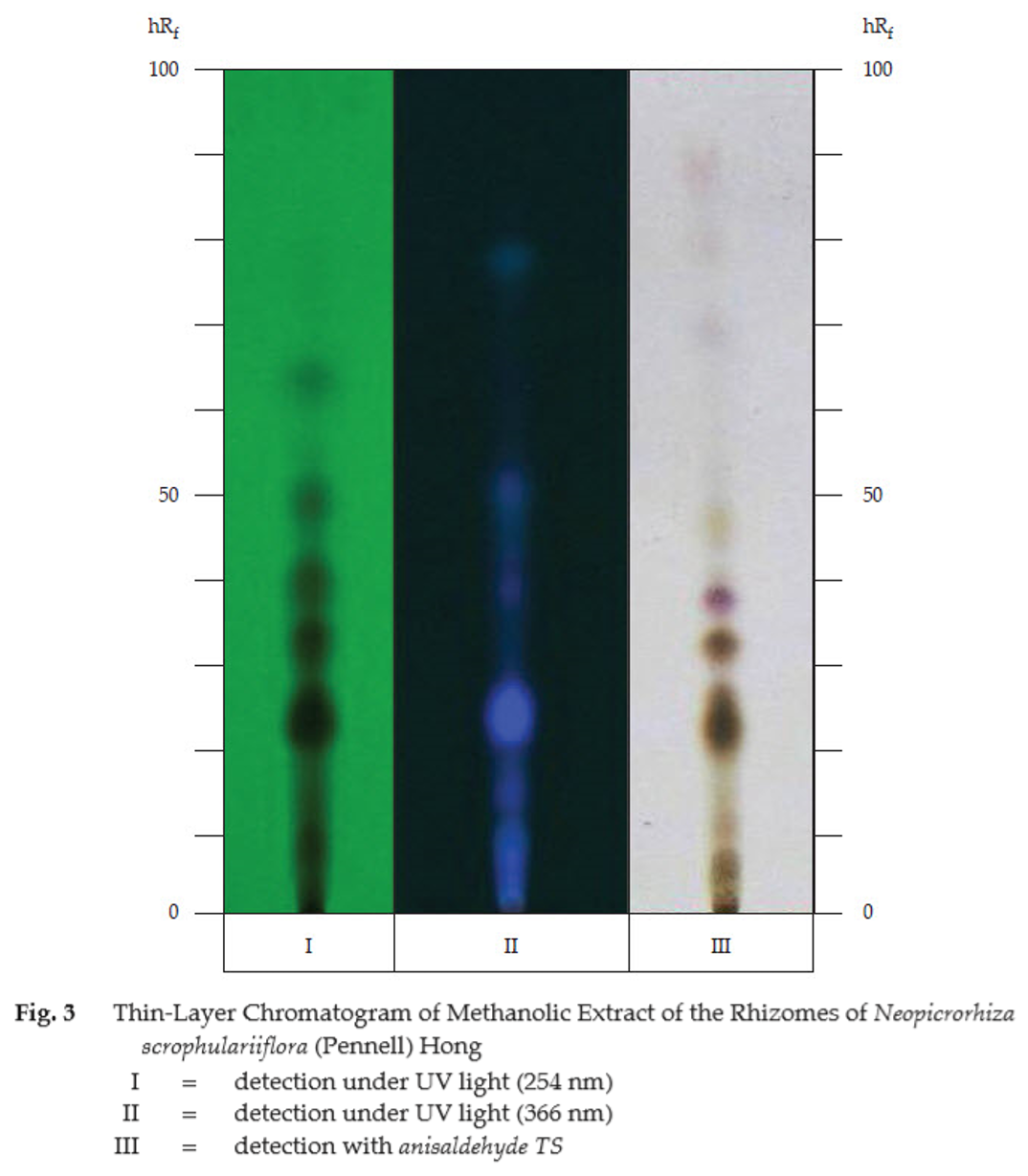ตำรามาตรฐานยาสมุนไพรไทย
Thai Herbal Pharmacopoeia
สำนักยาและวัตถุเสพติด กรมวิทยาศาสตร์การแพทย์ กระทรวงสาธารณสุข
Bureau of Drug and Narcotic, Department of Medical Sciences, Ministry of Public Health(Tinospora crispa (L.) Hook.f. & Thomson)
(Nelumbo nucifera Gaertn.)
(Centella asiatica (L.) Urb.)
(Centella Dry Extract)
(Centella Cream)
(Mesua ferrea L.)
(Piper sarmentosum Roxb.)
(Piper sarmentosum Roxb.)
(Pterocarpus santalinus L. f.)
(Santalum album L.)
(Senna tora (L.) Roxb.)
(Senna alata (L.) Roxb.)
(Senna Alata Tea)
(Piper retrofractum Vahl)
(Myristica fragrans Houtt)
(Andrographis paniculata (Burm. f.) Nees)
(Andrographis Capsules)
(Allium ascalonicum L.)
(Ocimum tenuiflorum L.)
(Curcuma longa L.)
(Turmeric Capsules)
(Turmeric Dry Extract)
(Turmeric Dry Extract Capsules)
(Arcangelisia flava (L.) Merr.)
(Curcuma sp.)
Harrisonia perforata (Blanco) Merr.
(Aristolochia pierrei Lecomte)
(Zingiber officinale Roscoe)
(Ginger Capsules)
(Ginger Tea)
(Cassia fistula L.)
(Nardostachys jatamansi (D. Don) DC.)
(Angelica sinensis (Oliv.) Diels)
Artemisia annua L.
(Ligusticum sinense Oliv. cv. Chuanxiong)
(Neopicrorhiza scrophulariiflora Pennell)
(Atractylodes lancea (Thunb.) DC.)
(Aucklandia lappa Decne)
(Terminalia chebula Retz.)
(Angelica dahurica (Hoffm.) Benth. & Hook. f. ex Franch. & Sav. var. dahurica)
(Kaempferia parviflora Wall. ex Baker)
(Hibiscus sabdariffa L.)
(Roselle Tea)
(Allium sativum L.)
(Zingiber zerumbet (L.) Sm.)
(Wurfbainia testacea (Ridl.) Škorničk.& A. D. Poulsen)
(Cannabis sativa L.)
(Myristica fragrans Houtt)
(Dracaena cochinchinensis (Lour.) S. C. Chen)
(Ficus racemosa L.)
(Hyptis suaveolens (L.) Poit.)
Clerodendrum indicum (L.) Kuntze
(Phyllanthus emblica L.)
(Citrus hystrix DC.)
(Citrus hystrix DC.)
(Areca catechu L.)
(Momordica charantia L.)
Moringa oleifera Lam.
(Aegle marmelos (L.) Corrêa)
(Solanum trilobatum L.)
(Morus alba L.)
Gynostemma pentaphyllum(Thunb.)
Makino
(Clinacanthus nutans (Burm. f.) Lindau)
(Cissus quadrangularis L.)
(Mimusops elengi L.)
(Zingiber montanum (J. König) Link. ex A. Dietr.)
(Piper betle L.)
(Capsicum annuum L.)
(Capsicum Oleoresin)
(Capsicum Gel)
(Piper nigrum L.)
(Piper nigrum L.)
(Eurycoma longifolia Jack)
(Thunbergia laurifolia Lindl.)
(Piper wallichii (Miq.) Hand.-Mazz.)
Senna garrettiana (Craib) H. S. Irwin & Barneby
(Terminalia bellirica (Gaertn.) Roxb.)
(Terminalia chebula Retz.)
(Caesalpinia bonduc (L.) H. Roxb.)
(Tarlmounia elliptica (DC.) H. Rob., S. C. Keeley, Skvaria & R. Chan)
(Hog Creeper Vine Dry Extract Capsiles)
(Hog Creeper Vine Dry Extract)
(Brachypterum scandens (Roxb.) Miq.)
(Lepidium sativum L.)
(Nigella sativa L.)
(Cuminum cyminum L.)
(Foeniculum vulgare Mill.)
(Plantago ovata Forssk.)
(Pimpinella anisum L.)
(Carum carvi L.)
(Anethum graveolens L.)
(Trachyspermum ammi (L.) Sprague)
Albizia procera (Roxb.) Benth.
(Acorus calamus L.)
(Tiliacora triandra (Colebr.) Diels)
Cyanthillium cinereum (L.) H. Rob.
(Orthosiphon aristatus (Blume) Miq.)
Murdannia loriformis (Hassk.) R. S. Rao & Kammathy
(Capparis micracantha DC.)
(Chrysopogon zizanioides (L.) Roberty)
(Cyperus rotundus L.)
(Cannabis sativa L.)
(Syzygium aromaticum (L.) Merr. & L. M. Perry)
(Boesenbergia rotunda (L.) Mansf.)
(Acanthus ebracteatus Vahl)
(Acanthus ilicifolius L.)
(Kaempferia galanga L.)
(Curcuma comosa Roxb.)
Betula alnoides Buch.-Ham. ex D. Don
Cannabis sativa L.
Carthamus tinctorius L
Mitragyna speciosa (Korth.) Havil
Mallotus repandus (Rottler) Müll. Arg
Azadirachta indica A. Juss. var. siamensis Valeton
Azadirachta indica A. Juss. var. siamensis Valeton
Punica granatum L.
Rhinacanthus nasutus (L.) Kurz
Baliospermum solanifolium (Burm.) Suresh
Curcuma aeruginosa Roxb
Boesenbergia kingii Mood & L. M. Prince
Senegalia rugata (Lam.) Britton & Rose
Acacia concinna (Willd.) DC.
Senegalia rugata (Lam.) Britton & Rose
Acacia concinna (Willd.) DC.
Senna alexandriana Mill. var. alexandriana
Cassia acutifolia Delile, Cassia angustifolia Vahl
Butea superba Roxb. ex Willd.
[Plaso superba (Roxb. ex Willd.) Kuntze, Rudolphia superba (Roxb. ex Willd.) Poir.
Pueraria candollei Graham
ex Benth. var. mirifica (Airy Shaw & Suvat.) Niyomdham
Streblus asper Lour.
Suregada multiflora (A. Juss.) Baill. (Gelonium
multiflorum A. Juss.
Figwortflower Picrorhiza Rhizome is the dried rhizome of Neopicrorhiza scrophulariiflora (Pennell) Hong (Picrorhiza scrophulariiflora Pennell) (Family Plantaginaceae), Herbarium Specimen Number: see Additional information 1, Crude Drug Number: DMSc 0936.
Constituents Figwortflower Picrorhiza Rhizome contains iridoid glycosides (e.g., kutkoside, picrosides, picrorosides) and cucurbitacin triterpenoids. It also contains apocynin, cinnamic acid, vanillic acid, etc.
Description of the plant (Figs. 1a, 1b) Perennial herb 4 to 30 cm tall; rhizome elongated, 15 to 25 cm long, about 1 cm in diameter, giving rise to stems and roots; root stout. Leaves simple, spiral, basal leaves fasciculate, spathulate or narrowly elliptic, 5 to 15 cm long, upper leaves spathulate, 5 to 10 cm long, apex obtuse, base attenuate, margin serrate, leathery, black when dry. Inflorescence spike, terminal; scape semi-cylindrical, 5 to 15 cm long, naked or with few bracts below the inflorescence; bract elliptic or lanceolate, about half of the length of the sepal. Flowers numerous, pale blue to dark purple, hirsute; calyx nearly equally 5-partite; corolla 8 to 10 mm long, bilabiate, upper lip 1-lobed, hooked, emarginate, lower lip 3-lobed, about half the length of the upper lip; stamens 4, more or less equalling corolla, exerted from corolla tube, anther divergent; ovary superior, 2-loculed, ovules numerous per locule, style 1, stigma capitate. Fruit capsule, septicidally dehiscent, ellipsoid or ovoid, about 1 cm long, turgid, tapered at top. Seeds numerous, about 1 mm long.
Description Odour, characteristic; taste, extremely bitter
Macroscopical (Fig. 1a) Dried rhizome, cylindrical, 2.5 to 12 cm long, about 1 cm wide, easily broken, externally greyish brown, rough, irregularly wrinkled, sometimes bearing roots, or circular root scars and bud scales. Broken, surface black, surrounding with white vascular bundle.
Microscopical (Figs. 2a, 2b) Transverse section of the rhizome shows periderm, cortex, vascular tissue, and pith. Periderm, several layers of cork cells and some of which in the outer layer cracked. Cortex, broad zone of thin-walled polygonal parenchyma with scattered groups of fibres. Vascular tissue, secondary phloem, xylem and broad zone of medullary ray. Pith, numerous thin-walled polygonal parenchyma.
Figwortflower Picrorhiza Rhizome in powder possesses the diagnostic microscopical characters of the unground drug. Parenchyma with dark brown substance and beaded-wall parenchyma are characteristic.
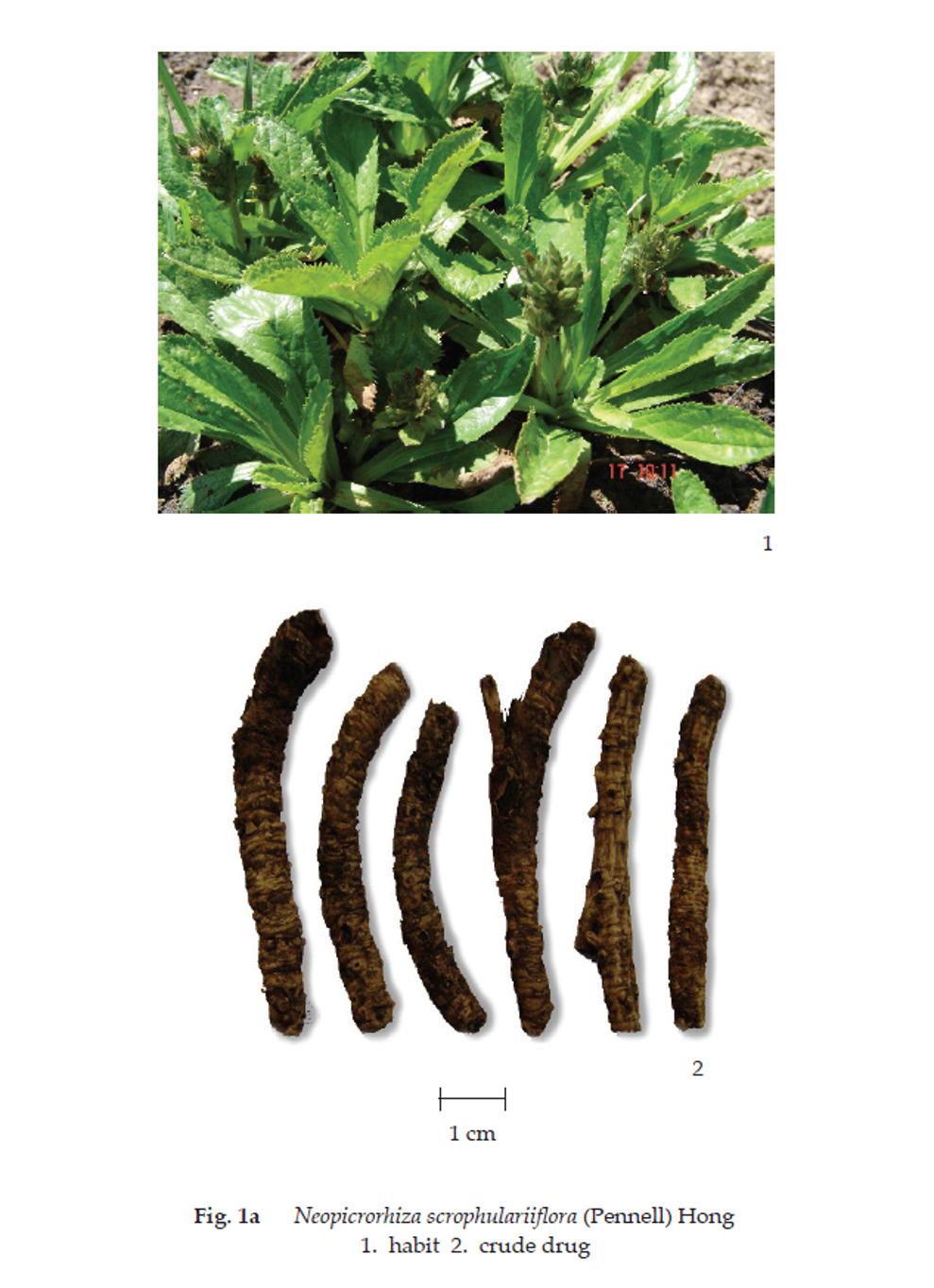
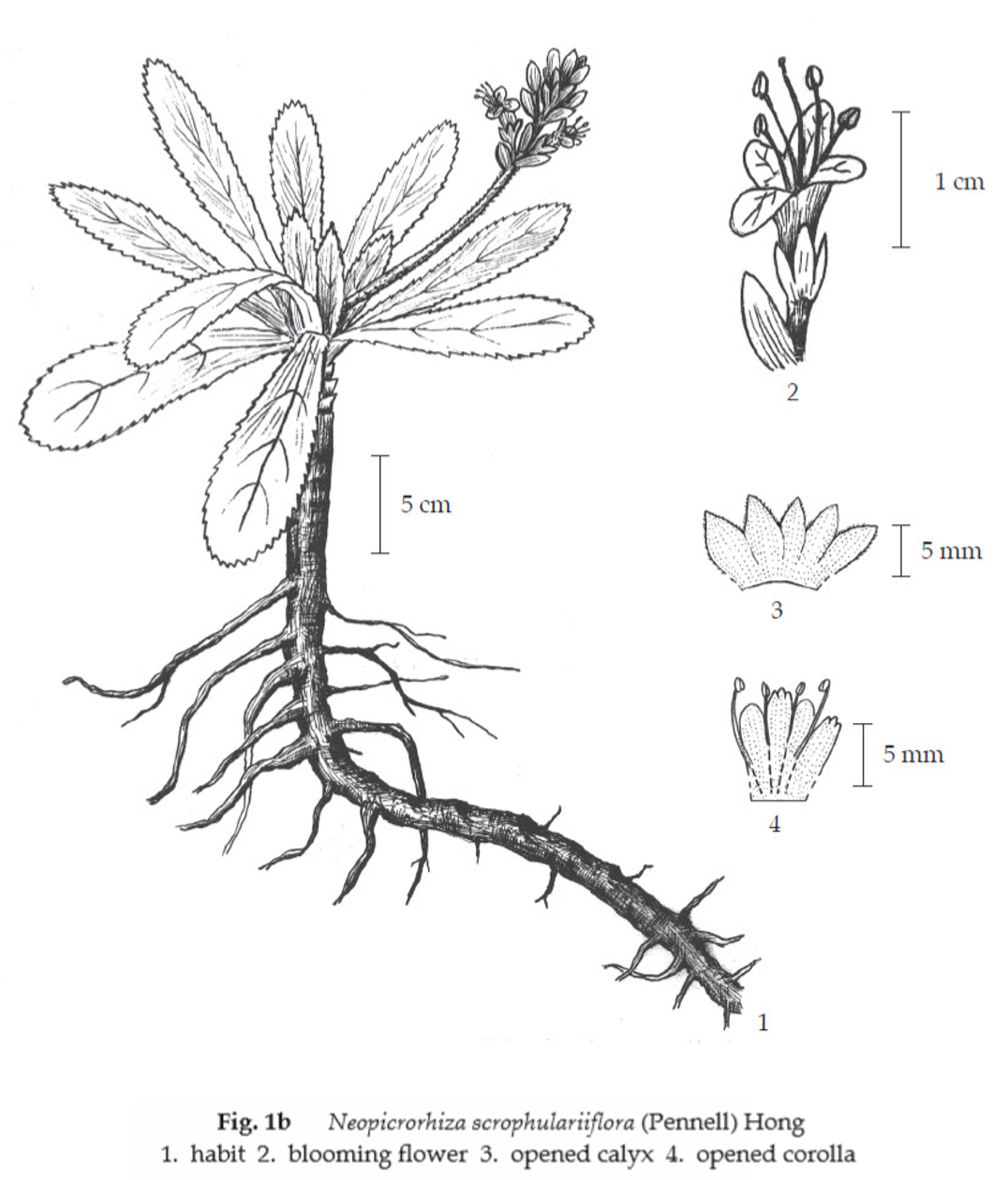
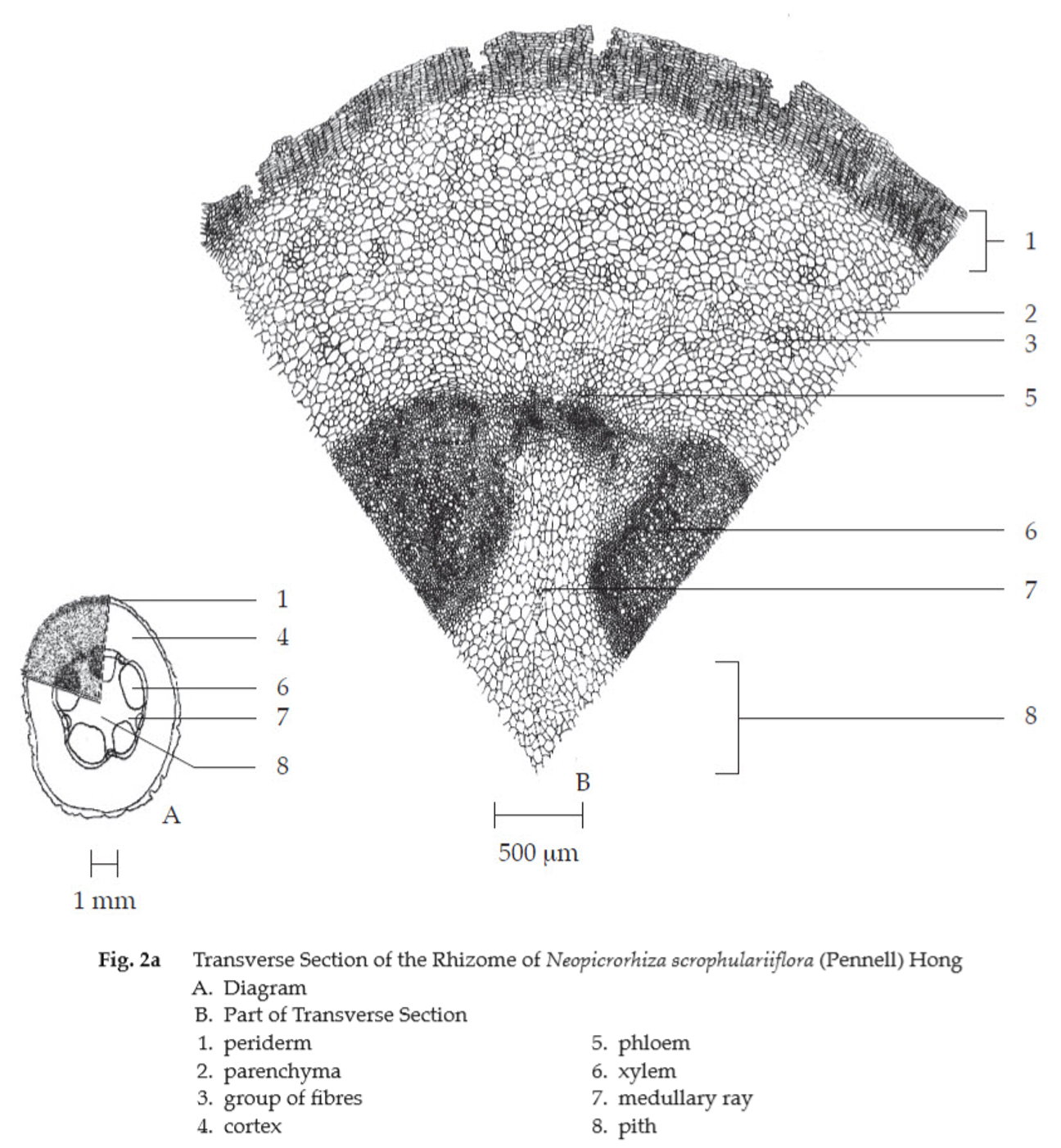
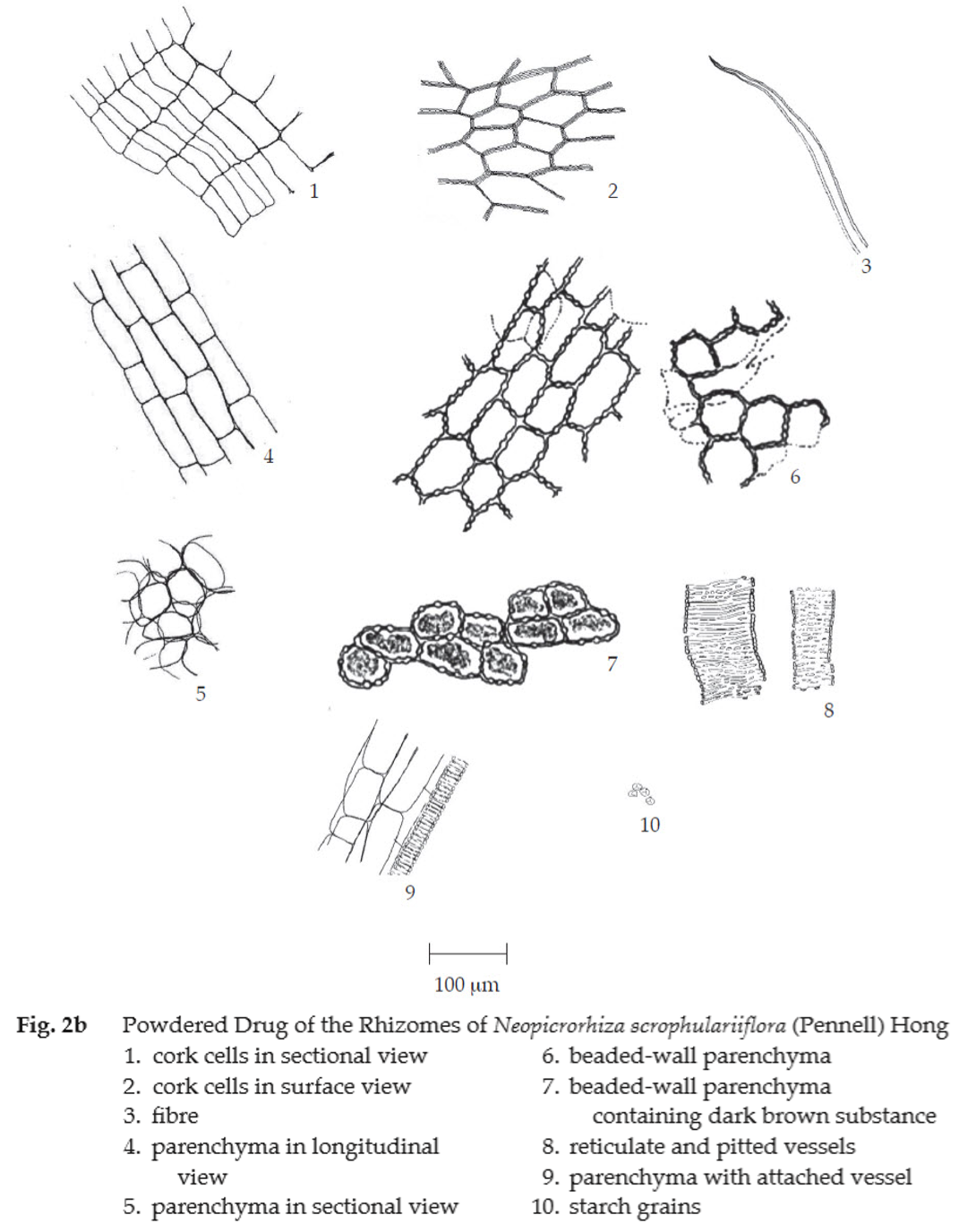
Additional information
1. Figwortflower picrorhiza plant is not native to nor commercially cultivated in Thailand. The plant yielding figwortflower picrorhiza rhizome is here referred to the herbarium specimen number 01434339 (PE), deposited at the Institute of Botany (PE), Chinese Academy of Sciences, Beijing, People’s Republic of China. The photographic illustration of the specimen can be seen at the Department of Medical Sciences Herbarium (DMSC), Nonthaburi, Thailand.
2. It is commonly used with other herbal drugs in Thai traditional herbal preparations.
Packaging and storage Figwortflower Picrorhiza Rhizome shall be kept in well-closed containers, protected from light, and stored in a dry place.
Identification
A. Heat 500 mg of the sample, in powder, with 10 mL of water in a water-bath for 10 minutes, allow to cool and filter. To 2 drops of the filtrate, add a few drops of a 1 per cent w/v solution of iron(III) chloride: a dark green colour is produced.
B. Carry out the test as described in the “Thin-Layer Chromatography” (Appendix 3.1), using silica gel GF254 as the coating substance and a mixture of 50 volumes of chloroform, 30 volumes of ethyl acetate, 20 volumes of methanol and 1 volume of strong ammonia solution as the mobile phase and allowing the solvent front to ascend 10 cm above the line of application. Apply to the plate, 5 μL of the test solution prepared by refluxing 1 g of the sample, in powder, in 25 mL of methanol for 30 minutes, filtering and evaporating the filtrate to dryness. Dissolve the residue in 1 mL of methanol. After removal of the plate, allow it to dry in air and examine under ultraviolet light (254 nm), marking the quenching spots. Examine the plate under ultraviolet light (366 nm) through the cut-off filter. Several blue fluorescent spots are observed. Spray the plate with anisaldehyde TS and heat at 110° for 10 minutes. Several spots of different colours are observed (Table 1); see also Fig. 3.
Table 1 hRf Values of Components in Methanolic Extract of the Rhizomes of Neopicrorhiza scrophulariiflora (Pennell) Hong
| Spot | hRf Value | Detection | ||
| UV 254 | UV 366 | Anisaldehyde TS | ||
| 1 2 3 4 5 6 7 8 9 10 |
4-10 20-27 29-34 35-41 45-49 47-51 60-64 67-71 76-79 83-87 |
quenching quenching quenching quenching - quenching quenching - - - |
blue intense blue - blue - instense blue - - blue - |
brown brown brown violet pale brown - - pale violet pale violet pale violet |
Loss on drying Not more than 11.0 per cent w/w after drying at 105° to constant weight (Appendix 4.15).
Foreign matter Not more than 2.0 per cent w/w (Appendix 7.2).
Acid-insoluble ash Not more than 2.0 per cent w/w (Appendix 7.6).
Total ash Not more than 5.0 per cent w/w (Appendix 7.7).
Ethanol-soluble extractive Not less than 30.0 per cent w/w (Appendix 7.12).
Dose 1 to 3 g of the powdered drug a day.
